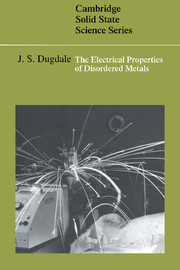Book contents
- Frontmatter
- Contents
- Preface
- 1 Context and content
- 2 Production and structure of metallic glasses
- 3 Electron transport in metals: introduction to conventional theory
- 4 Scattering
- 5 Simple liquid metals: Ziman theory
- 6 Phonons in disordered systems
- 7 Interactions and quasi-particles
- 8 Transition metals and alloys
- 9 The Hall coefficient of metallic glasses
- 10 Magnetoresistance
- 11 Electrical conductivity of metallic glasses: weak localisation
- 12 The interaction effect or Coulomb anomaly
- 13 The effect of the Coulomb interaction on conductivity
- 14 Influence of a magnetic field on the enhanced interaction effect
- 15 The thermopower of metals and alloys
- 16 Comparison with experiment
- Appendices
- Notes
- References
- Index
9 - The Hall coefficient of metallic glasses
Published online by Cambridge University Press: 21 January 2010
- Frontmatter
- Contents
- Preface
- 1 Context and content
- 2 Production and structure of metallic glasses
- 3 Electron transport in metals: introduction to conventional theory
- 4 Scattering
- 5 Simple liquid metals: Ziman theory
- 6 Phonons in disordered systems
- 7 Interactions and quasi-particles
- 8 Transition metals and alloys
- 9 The Hall coefficient of metallic glasses
- 10 Magnetoresistance
- 11 Electrical conductivity of metallic glasses: weak localisation
- 12 The interaction effect or Coulomb anomaly
- 13 The effect of the Coulomb interaction on conductivity
- 14 Influence of a magnetic field on the enhanced interaction effect
- 15 The thermopower of metals and alloys
- 16 Comparison with experiment
- Appendices
- Notes
- References
- Index
Summary
The Hall coefficient of simple liquid metals is, for the most part, freeelectron- like. This is true, for example, of liquid Na, K, Rb, Cs, Al, Ga, In, Zn, Ge, Sn, and of liquid Cu, Ag and Au. This is also true of a wide range of non-transition metal glassy alloys of which some examples (out of many) are given in Table 9.1. Departures from the free-electron value are, however, found, for example in Ca-Al alloys and, as the table shows, in metallic glasses containing transition metal elements, which can show positive Hall coefficients in circumstances where hole conduction can scarcely be involved. To explain these positive values thus poses a problem; it emphasises still more the importance of the transition metal alloys. We must therefore look at the theory of the Hall coefficient, in particular that of alloys containing transition metals, whose behaviour forces us to recognise that the Ziman theory cannot be the whole story.
Conventional theory
Let us first consider the predictions of conventional theory for the Hall coefficient of a metal. In a crystalline metal the Hall coefficient can be difficult to calculate because it depends in a fairly complicated way on the shape of the Fermi surface and on how the electron velocities and relaxation times vary over the surface.
- Type
- Chapter
- Information
- The Electrical Properties of Disordered Metals , pp. 81 - 99Publisher: Cambridge University PressPrint publication year: 1995



